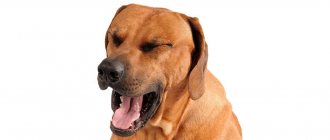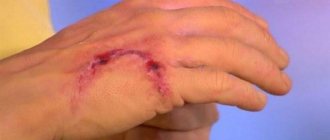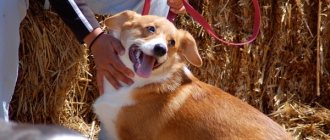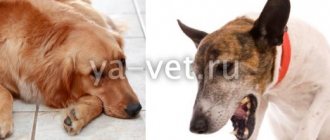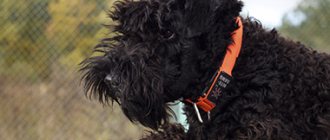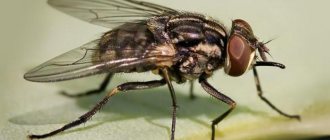Toy terriers, representatives of the class of decorative dogs, infinitely sweet and devoted creatures, will become a family favorite and your constant companion.
After all, having a compact size, they can fit even into a medium-sized handbag and travel with their beloved owner.
Also, toys do not require complex care and regular walks - they can go to the toilet in the tray.
They will never cease to delight you with their playful character and cheerful disposition.
But, like any other living beings, they also have health problems.
Let's look at the case when your pet wheezes and suffocates.
Physiological features of toy terriers
The Toy Terrier is a small (also called “pocket”) dog, with an average height of 20-30 cm and an average weight of 1.5 to 3 kg.
live
from 12 to 15 years .
These pets are thin-boned, with high legs, square in shape with angular muscles. A wedge-shaped head, a rounded skull and a convex wide forehead are also characteristic features of the breed.
Read more about what Toy Terriers look like here.
To establish proper dog breathing, the transverse cartilaginous half-rings of the trachea provide the necessary rigidity so that the trachea does not collapse during inhalation, and the softer parts ensure its plasticity.
Causes of wheezing and difficulty breathing
Sometimes toy owners may notice strange noises, reminiscent of wheezing, when the pet breathes, especially during active play, after eating and drinking water, and also when the pet is nervous (at such moments the toy also usually trembles), that is, during moments of intense and deep breathing .
Sometimes the owner does not attach much importance to this, but wheezing can be an alarming symptom and be in the nature of a pathology of the respiratory system.
Let's look at the main reasons why a toy terrier may wheeze and choke.
Development of tracheal collapse
This defect is caused by compression (narrowing) of the tracheal lumen due to softening and laxity of the tracheal cartilage.
This condition causes a temporary spasm of the larynx, and the dog coughs as if he wants to get rid of a foreign object, wheezes and even grunts his nose.
It is necessary to take into account the fact that toy terriers are prone to lung collapse, so it is important to notice other symptoms of this disease.
At the first appearance of a cough, you should go to the hospital, and then undergo regular examinations as prescribed by a veterinarian.
Entry of foreign bodies into the oral cavity
Since representatives of the toy terrier breed are especially inquisitive, when examining a small thing, they can accidentally swallow it, and, once in the respiratory tract, the foreign body causes wheezing and makes it difficult for the dog to breathe.
Allergic reaction
As a result of an allergic reaction, the animal may also experience wheezing and shortness of breath, sometimes accompanied by a cough . Due to the action of the irritant, laryngospasm or swelling of the larynx occurs.
The causes of allergies in toys can be:
- Food;
- household chemicals;
- medicines;
- fur of other animals and so on.
Heart failure, heart attack
This is a serious cause of wheezing and heavy breathing in your pet and requires immediate hospitalization.
IMPORTANT!
If there are heart problems, wheezing and shortness of breath are accompanied by symptoms such as a blue tongue and withdrawal of paws.
In this case, the dog must immediately receive a heart injection.
Pulmonary edema
Pulmonary edema can cause wheezing and shortness of breath; the edema itself also has certain causes, it can be either heart failure or some kind of viral infection.
Psychological reasons (emotional overexcitement)
A pet may begin to choke due to fear (loud noise), excitement, intense joy, etc.
Owners of particularly sensitive pets carry with them sedatives prescribed by a doctor..
Expert opinion
Tolkachev Andrey Mikhailovich
veterinarian
“If you notice a single instance of wheezing in your Toy Terrier, it may be due to the 'reverse cough or sneeze effect'. The attack can be compared to a sharp breath. At the same time, while the dog is not able to exhale on its own, a moment of lack of air occurs, the dog suffocates and coughs up. This is due to the physiology of the animal. If the symptoms are constant, and are accompanied by a cough and general malaise, then this is a reason to contact a specialist.”
When a dog itches
If your pet is actively itching, then this symptom may be ambiguous. The first step is to examine the dog for the presence of fleas, from which it is impossible to protect even the cleanest animals. Parasites and their larvae can enter the house with people's shoes.
We suggest you read: Industrial cat food advice from veterinarians
It is necessary to remove fleas not only from the animals themselves. Fleas and their larvae can be in any objects that the dog comes into contact with.
All things need to be vacuumed well, shaken out in the fresh air, and washed if possible. Fleas can be removed using products specifically designed for this purpose.
The veterinary pharmacy offers products to kill both adult fleas and prevent re-infection. An anti-flea collar helps to combine both methods of getting rid of the disease.
Since they tend to multiply quickly, if you do not start fighting them immediately after they are discovered, after 1-2 weeks the animal will seriously suffer from an entire army of fleas.
To remove them completely, as a rule, a repeat procedure is required. The re-processing period is indicated in the instructions. Fleas can go without food for a long time.
Some time after treating the animal itself and the bedding, fleas may appear again.
If the animal itches, but there are no fleas, then the discomfort may be caused by cutting the fur. If your pet still continues to itch and bites its paws, then the animal may have liver and heart diseases. To clarify the situation, the help of a veterinarian is required.
Not only fleas, but also other parasites can cause suffering. You need to inspect the fur especially carefully during the tick season.
Allergies can also cause itching. Dry food should be limited in your pet's diet.
Carefully inspect the skin for splinters or other foreign elements trapped under the skin.
Symptoms of the disease
The main signs indicating that wheezing is a consequence of the disease are:
- persistent cough (wet or dry);
- the appearance of moist rales;
- wet rales;
- crackling wheezing;
- blue or purple tongue during attacks.
Moist rales indicate the presence of blood or fluid accumulation in the lungs and upper respiratory tract.
A sign of the progression of the disease is the transition of moist rales to crackling sounds, which can also be heard when exhaling.
Their presence is a symptom that pulmonary emphysema, fibrosis or pneumonia is developing.
What are the causes of cough
Why does the dog cough? Most breeders mistakenly believe that coughing in dogs is nothing more than a common cold. But this is fundamentally not true, and one should not attribute the pet’s poor health to this reason.
As practice shows, there can be a lot of reasons, all of them are discussed below:
- sometimes this may be a feature of a particular breed;
- tonsillitis;
- diseases of the oral cavity;
- viral tracheobronchitis;
- diseases of gums and teeth;
- spread of parasitic organisms;
- collapse of the trachea;
- tumor in the lungs;
- heart disease;
- an allergic reaction to something.
Viral cough
One of the most common reasons why a pet may cough is a viral cough. Typically, this disease manifests itself in the form of aviary cough or tracheobronchitis. As practice shows, infection is transmitted quite quickly as a result of contact with an infected pet. It only takes a minute of contact for your pet to get sick.
At the very early stage, the dog will cough, as if he is trying to burp something. After some time, the pet vomits white foam. The first thing you should do is take your pet to a specialist; subsequent treatment is carried out only after a complete examination of the patient by a doctor.
- At home, dry cough in pets is treated with antibiotics;
- an animal's irritated trachea can be treated with special anti-cough medications;
- if the dog wheezes and vomits white foam, treatment can be carried out using medications prescribed by a doctor;
- when your pet loses its appetite and refuses food, prevent contact with other pets;
- for enlarged tonsils, doctors usually prescribe the use of expectorants (video author - Ludmila Podgaevskaya).
Mechanical damage and foreign bodies
It often happens that the pet not only coughs, but also wheezes, and blood comes out of the mouth. Apparently, in this case the cause is the presence of a foreign object in the body. All breeders know that animals often swallow various things, but they are usually digested in the stomach. So, if a dog wheezes and blood comes out of his mouth, then this happens quite rarely. The cause may be damage to the central nervous system or rapid swallowing of food, which is especially important for pets of small breeds.
A similar cough may also occur as a result of collar strangulation. In addition, the cause may be a tumor or the presence of fluid in the respiratory tract. One way or another, the only thing you need to do is seek help from a specialist.
The main symptoms are as follows:
- the dog may try to burp;
- the dog wheezes, vomits, sometimes foam;
- the animal sneezes;
- saliva and blood are released from the mouth;
- the dog does not want to eat or drink;
- foam may come out of the nose (video author - dog-channel.tv).
Allergic cough
In both a puppy and an adult, coughing sometimes appears only at certain times of the year. If this is the case, then most likely your pet simply has an allergy. However, the cause of the appearance of the symptom can also be the animal’s reaction to the bites of various insects. In addition, the cause of an allergic cough may well be dust or certain substances in the diet.
Just giving a dog or puppy a drug to relieve allergy symptoms is not an option. In order for the treatment to be most effective, it is first necessary to find out why the allergy appeared. Of course, this is difficult to do at home. If your pet is allergic to food, then this can be understood by changing the diet. However, only an examination by a veterinarian will allow you to quickly obtain a more accurate result.
What to do if your pet is wheezing and has difficulty breathing?
Before the animal is examined by a doctor to improve its condition, you can provide all possible assistance.
It will be as follows:
- you need to try to calm the dog down and provide a flow of fresh air;
- a complex attack can be relieved by briefly pressing your fingers to the dog’s nostrils;
- you can take the dog in your arms and massage the trachea, making efforts during moments of wheezing (only in case of collapse of the trachea, in other cases try not to touch the chest);
- if the dog allows, you can inspect the mouth for the presence of foreign objects.
The dog is coughing as if he was choking
You need to understand that coughing is a nonspecific sign of many pathologies, so you cannot immediately conclude that the dog is choking. First, take a closer look at the moment the cough appears. If the symptom appears in your pet while eating or when he is gnawing on something, then it is likely that he was choking. Otherwise, a cough indicates other possible diseases.
A foreign object is indicated by the cough and the absence of additional symptoms. A cough due to bronchitis or another disease is necessarily accompanied by other symptoms. When a dog chokes on grass or another object, there are no additional signs of illness. The pet was just playing and having fun, gnawing on a stick, and a second later he started coughing - this is a sure sign that the dog is choking and is coughing from this.
Typically, this type of cough ends with the object being expelled from the throat and the pet spitting it out or chewing and swallowing it again. Also, a sharp development of cough indicates a foreign object. In pulmonary diseases, the cough increases gradually, initially it is hoarse and whistling. If the dog is choking, the cough will be strong and sharp immediately, with no additional noise (whistle or gurgle).
Treatment methods
Any treatment begins with a diagnosis. If it turns out that wheezing and difficulty breathing in a toy terrier occurs as a result of the progression of the disease, it is necessary to begin treatment immediately.
NOTE!
It is necessary to undergo radiography, laryngo-tracheo-bronchoscopy and other types of diagnostics.
- Tracheal collapse in toy terriers is treated with medication. Treatment takes a lot of time, but the outcome of therapy is usually positive.
The treatment plan usually looks like this:
- prescribing drugs that can dilate the airways (for example, the drug aminophylline, which is a bronchodilator);
- taking antibiotics to restore the ciliated epithelium, remove pathogenic microbes, eliminate infection;
- strict diet to identify irritating symptoms;
- when a blue tongue appears, tranquilizers are sometimes prescribed to relieve shock, excitement and normalize the animal’s breathing;
- a course of oxygen therapy may be prescribed.
Animals with severe manifestations of tracheal collapse are prescribed surgical intervention, which consists of surgically installing a polypropylene or silicone implant to support the tracheal cartilages.
- For laryngospasm and laryngeal edema, medications are prescribed to help relieve swelling. Sometimes artificial ventilation is performed.
- If a foreign body enters the respiratory tract, bronchoscopy should be performed, followed by endoscopic removal.
- If wheezing is caused by allergies, the doctor will additionally prescribe antihistamines. For viral infections, respectively, antiviral drugs and immunomodulators.
Diagnosis of the condition
If breathing problems are not associated with physiological causes, the owner should not hesitate to visit a specialized institution. A veterinarian will examine the animal’s nasopharynx and provide immediate assistance if the problem is a foreign object.
If polyps or neoplasms in the nasopharynx are suspected, as well as to determine the exact location of a foreign object, a veterinarian conducts an X-ray examination of the furry patient. X-rays are performed in frontal and lateral projections.
If there is a suspicion that difficulty breathing is associated with problems in the myocardium, the animal is prescribed an electrocardiographic and ultrasound examination of the heart.
Ultrasound of the heart
Parasitological examination and immunodiagnostic tests will help to exclude dirofilariasis. In some cases, a veterinarian prescribes a clinical and biochemical blood test.
READ HOW AND HOW OFTEN DO YOU NEED TO CHANGE THE WATER IN AN AQUARIUM » Home Aquarium
Diseases of an infectious nature are excluded using bacteriological or virological analysis of biological material.
